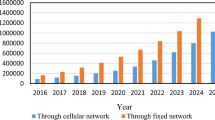Abstract
Imperfect channel state information (CSI) is among the main factors that affect system performance in wireless networks. In this paper, we investigate the impact of imperfect CSI on the performance of analog network coding (ANC) for a two-way relaying system based on opportunistic relay selection (ORS). An exact and generalized closed-form expression for system outage probability is presented in a Rayleigh flat-fading environment. To provide more insights, the closed-form asymptotic expression is then obtained. It is shown that the presence of channel estimation error causes outage probability maintain a fixed level even when a noiseless channel is adopted. Therefore, to mitigate the negative impact of imperfect CSI, we deduce the power allocation to minimize the system outage probability based on the knowledge of instantaneous channel information. Numerical results validate the accuracy of the derived expressions and highlight the effect of proposed power allocation algorithm compared with conventional uniform power allocation.




Similar content being viewed by others
Notes
Notations: We use \( x\sim \mathcal CN (a,b)\) to denote a complex Gaussian random variable \(x\) with mean \(a\) and variance \(b\). \(\mathbf{Pr}[\cdot ]\) and \(|\cdot |\) denote probability and absolute value respectively.
References
Rankov, B., & Wittneben, A. (2007). Spectral efficiency protocols for half-duplex fading relay channels. IEEE Journal of Selected Areas in Communications, 25, 379–389.
Zhang S. L., Liew C. S. & Lam P. P. (2006). Hot topic: Physical-layer network coding. Proceedings of ACM Mobicom, 358–365.
Duy, T. T., & Kong, H.-Y. (2013). Performance Analysis of two-wayhybrid decode-and-amplify relaying scheme with relay selection for secondary spectrum access. Wireless Personal Communications, 64, 857–878.
Zhang, J., Bai, B., & Li, Y. (2010). Outage-optimal opportunistic relaying for two-way amplify and forward relay channel. Electronics letters, 46, 595–597.
Ubaidulla, P., & Aissa, S. (2012). Optimal relay selection and power allocation for cognitive two-way relaying networks. Wireless Communications Letters, 1, 225–228.
Wang, L., Cai, Y. M., & Yang, W. W. (2012). On the finite-SNR DMT of two-way AF relaying with imperfect CSI. IEEE Wireless Communications Letters, 1, 161–164.
Wu, Y., & Patzold, M. (2012). Outage probability and power allocation of two-way amplify-and-forward relaying with channel estimation errors. IEEE Transaction on Wireless Communications, 11, 1985–1990.
Wang, C. Y., Lui, T. C.-K., & Dong, X. D. (2012). Impact of channel estimation error on the performance of amplify-and-forward two-way relaying. IEEE Transaction on Vehicular Technology, 61, 1197–1207.
Han, S., Ahn, S., Oh, E., & Hong, D. (2009). Effect of channel-estimation error on BER performance in cooperative transmission. IEEE Transaction on Vehicular Technology, 58, 4060–4070.
Yi, Z., Ju, M., & Kim, I.-M. (2011). Outage probability and optimum power allocation for analog network coding. IEEE Transactions on Wireless Communications, 10, 407–412.
Gradshteyn, I. S., & Ryzhik, I. M. (1994). Table of integrals, series, and products. FL: Academic, Orlando.
Abramowitz, M., & Stegun, I. A. (1965). Handbook of mathematical functions with formulas graphs, and mathematical tables. New York: Dover.
Moon, T. K., & Stirling, W. C. (2000). Mathematical methods and algorithms for signal processing. Englewood Cliffs, NJ: Prentice-Hall.
Acknowledgments
This work was supported by the National Basic Research Program of China (973 Program, No. 2012CB316100), the “111” project (Grant No. B08038), the National Natural Science Foundation of China (Grant Nos. 61101144 and 61101145), the Fundamental Research Funds for the Central Universities (K50510010017).
Author information
Authors and Affiliations
Corresponding author
Appendices
Appendix A
where \(\Phi = \frac{{P_r |\hat{h}_{ak} |^2 |\hat{h}_{bk} |^2 }}{{\left( {\alpha _{1k} |\hat{h}_{ak} |^2 + \alpha _{2k} |\hat{h}_{bk} |^2 } \right) \left( {\beta _{1k} |\hat{h}_{ak} |^2 + \beta _{2k} |\hat{h}_{bk} |^2 } \right) }} \ge 0\).
a) Clearly, when \(P_b \beta _{1k} - P_a \alpha _{1k} \ge 0\), i.e., \(\beta _{1k} /\alpha _{1k} \ge P_a /P_b,\, P_b \beta _{2k} - P_a \alpha _{2k} \ge 0\). From (20), we can obtain \(\gamma _{ak} \ge \gamma _{bk}\). Thus we have
b) Similarly, when \(P_b \beta _{2k} - P_a \alpha _{2k} \le 0\), i.e., \(\beta _{2k} /\alpha _{2k} \le P_a /P_b,\, P_b \beta _{1k} - P_a \alpha _{1k} \le 0\). From (20), we can obtain \(\gamma _{ak} \le \gamma _{bk}\). Thus we have
According to the above discussions, we can arrive at the criterion in (7).
Appendix B
As \(\gamma _{ak}\) and \(\gamma _{bk}\) are not independent, it is hard to evaluate (23) straightforward. By using the fact that \(\beta _{1k} /\alpha _{1k} < P_a /P_b\) and some manipulations, we can obtain
where \(X = |\hat{h}_{ak} |^2 \), \(Y = |\hat{h}_{bk} |^2 \), \(\vartheta _1 = \frac{{\alpha _{2k} \gamma _{th} Y}}{{P_r P_b Y - \alpha _{1k} \gamma _{th} }}\) and \(\vartheta _2 = \frac{{\beta _{2k} \gamma _{th} Y}}{{P_r P_a Y - \beta _{1k} \gamma _{th} }}\). Furthermore, by using \( \beta _{2k} /\alpha _{2k} > P_a /P_b\), (24) can be rewritten as
As \(X\) and \(Y\) are independent, we can evaluate \(\xi _{ak}\) as
where \(f_X(x)\) and \(f_Y(y)\) denote the probability density function (PDF) of \(X\) and \(Y\). Making the change of variable \(t = P_r P_a y - \beta _{1k} \gamma _{th}\) within the integral and applying the Taylor series expansion for the exponential term and with the help of [12], we can obtain the final form.
Similarly, \(\xi _{bk}\) can be evaluated as
The first term of (27) can be evaluated straightforward and the second term can be deduced by following the same approach as carried out to obtain \(\xi _{ak}\). Substituting \(\xi _{ak}\) and \(\xi _{bk}\) into (25) yields (10).
Rights and permissions
About this article
Cite this article
Zhang, C., Ge, J. & Li, J. Performance Analysis and Enhancement for Opportunistic Analog Network Coding with Imperfect CSI. Wireless Pers Commun 72, 2945–2956 (2013). https://doi.org/10.1007/s11277-013-1190-0
Published:
Issue Date:
DOI: https://doi.org/10.1007/s11277-013-1190-0




